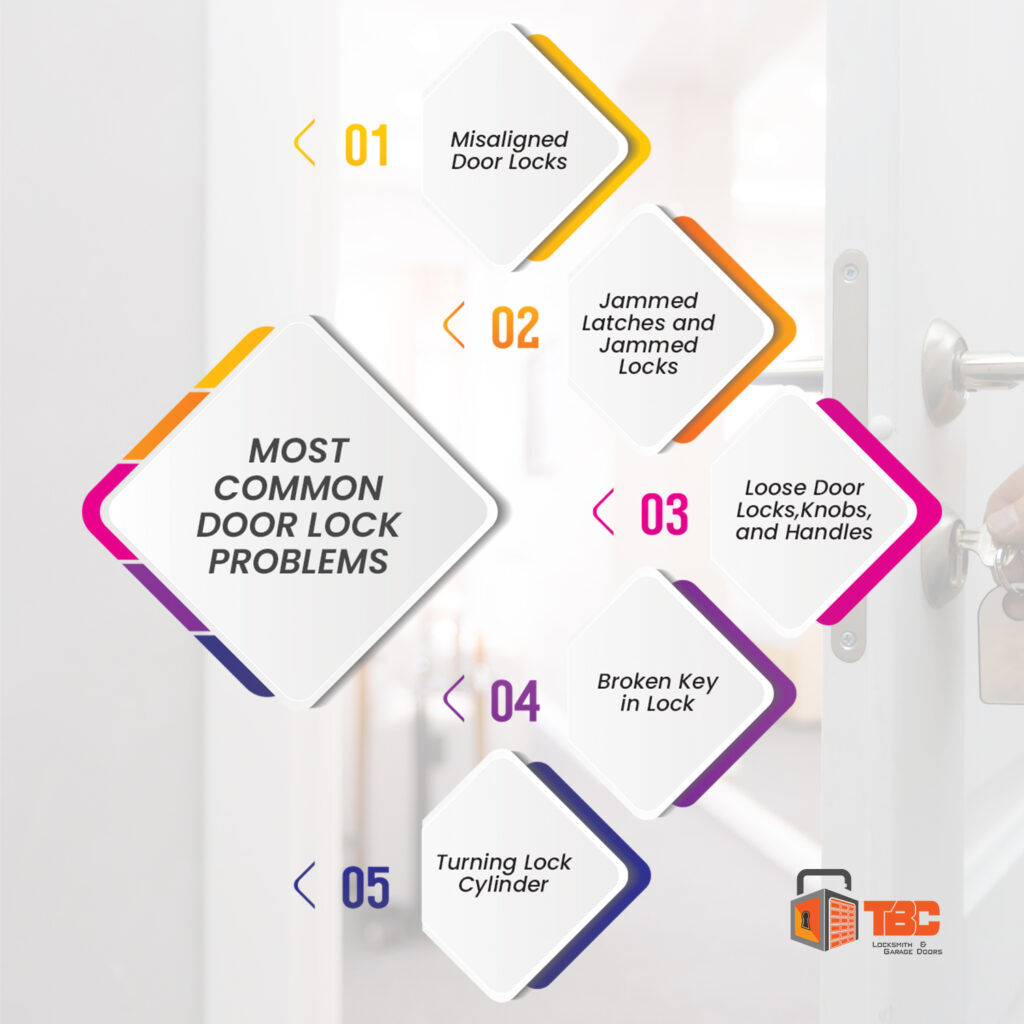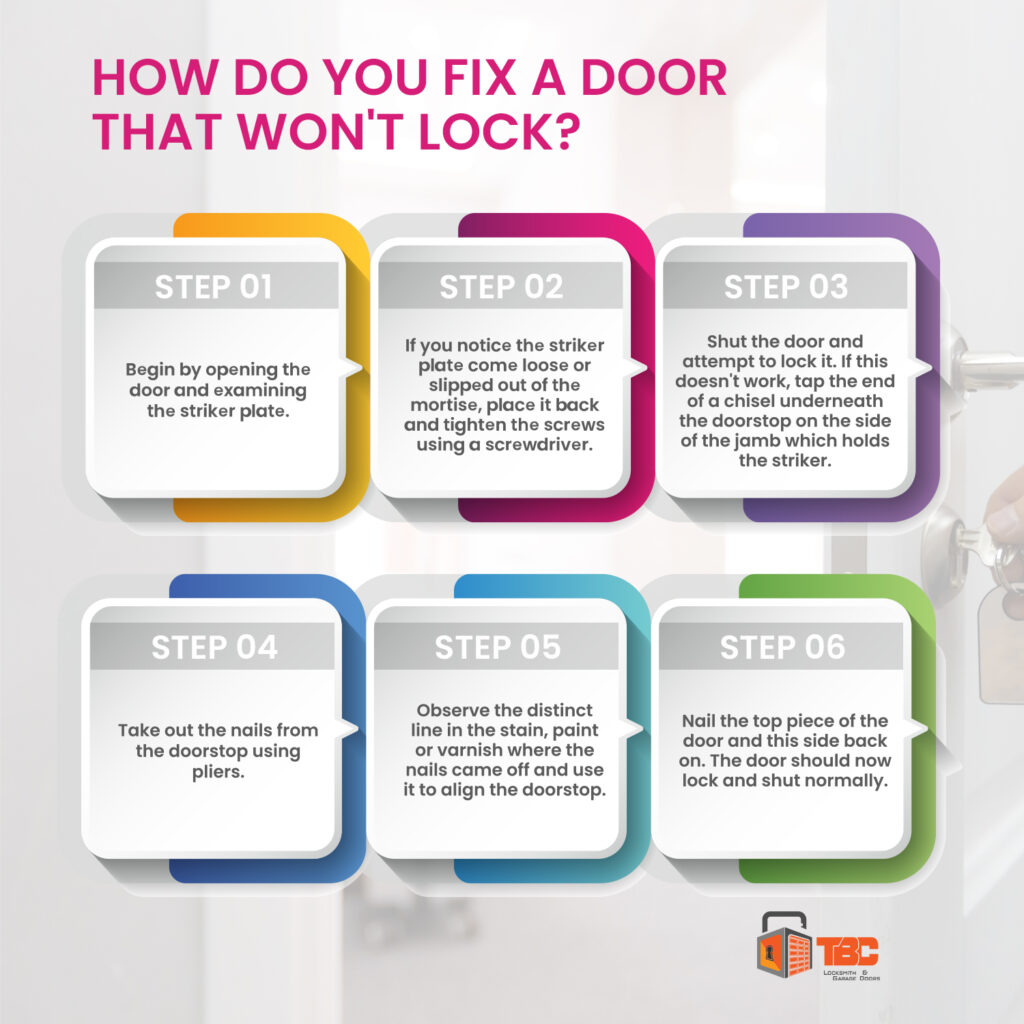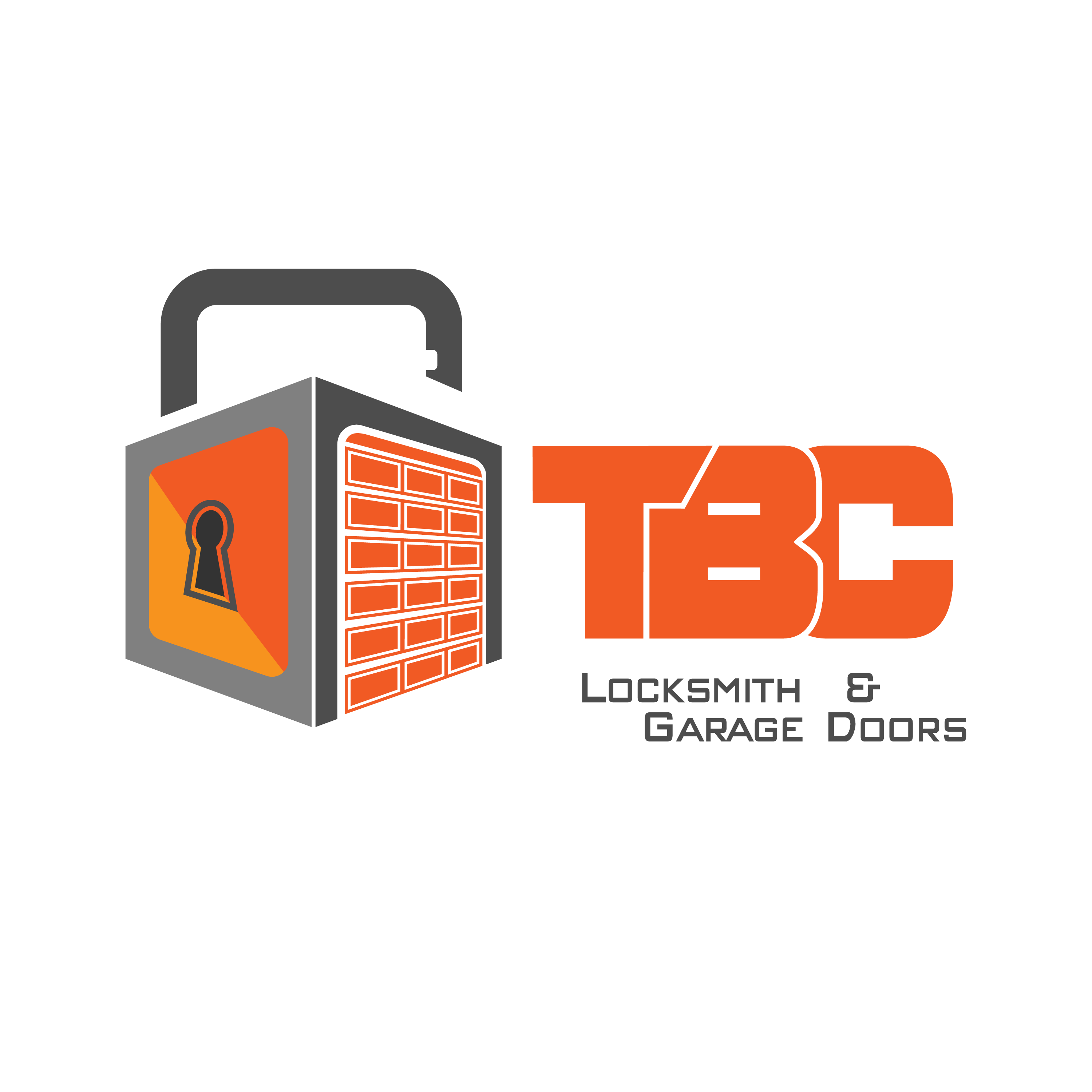Door lock problems pop up from time to time, making it something that every property owner must deal with. Many commercial property owners and homeowners will admit that they have encountered door lock problems at certain points. The way that door lock problems are handled determines what extent to which these problems will ultimately impact your security. Sadly, many people avoid calling a locksmith until it’s too late.
There are specific door lock problems you do not want to ignore because if not properly addressed, door lock problems can generate something worse. At times, door lock problems can make your security open to attack and vulnerable.
In this article, discover what the most common door lock problems are and how to handle them.
What Are the Most Common Door Lock Problems?

Some of the most common door lock problems homeowners have to deal with include:
Misaligned Door Locks
Misaligned door locks are often interchanged with misaligned strike plates. This is usually because thehy cause very similar door lock problems. A misaligned lock means that certain parts of the lock mechanism are not lined up to allow the core function of the door. In most cases, it means that the locking bolt or the latch does not line up with the strike plate of the door lock. A strike plate is mostly affixed to the door jamb, facilitating the extension of a latch or a bolt.
A misaligned latch or deadbolt is usually the result of a wrongly installed door lock or door frames that are wrapping due to climate changes. If your door lock is misaligned, it becomes hard to operate the door normally. This means that your door may not lock and close the way it should, leaving your office or home exposed.
If you do not correctly tackle the misaligned door lock, it can cause your door lock problems to worsen. A misaligned door lock can lead to broken doors or broken door locks. Because the locking mechanism is not aligned with the latch, you can cause your locking latch or bolt to undergo unnecessary pressure whenever you attempt closing the door. Eventually, you can damage your lock bolt. A damaged locking mechanism can lower security and lead to higher costs.
How To Fix Misaligned Door Locks
Carefully observe the door hinges and screws; in certain instances, it might be just your door that is misaligned, not your door lock. You can try tightening the screws in the hinges to help adjust your door to its correct configuration. Your door can sag and even buckle under its weight because of loose screws, so you need to ensure that you rule this out when going over door lock problems. If this doesn’t work, the problem is with your door lock alignment.
Proceed by adjusting the strike plate in the ock to ensure that t lines up correctly with the corresponding door lock bolt or latch. Ideally, the door bolt should rest flush within the plate. Unscrew the strike plate and attempt to reposition it. With some door locks, you might need to file sections of the strike plate for it to fit properly. After you have done this, install the strike plate at the appropriate height. Bear in mind that this might be a bit too complicated for you to do on your own, so do not hesitate to contact a locksmith Toronto.
Jammed Latches and Jammed Locks
Your locks can become jammed for various reasons. However, the most common reason for a lock getting jammed is the buildup of debris that clogs the internal mechanisms. If the lock bolt or latch is broken, the door lock can become jammed. Various reasons can cause these door lock problems, but the endpoint is usually the same. A jammed lock does not allow your door to function properly.
How To Fix Jammed Latches and Jammed Locks
First, you have to determine the cause of your jammed lock. If your lock is jammed due to a blocked keyway, rid the keyway of obstructions and dirt by cleaning it. You can do this by applying lube to clear it out.
If your door is jammed due to a broken latch or bolt, replace or repair the latch . With this kind of problem, you should contact a professional locksmith Toronto.
Loose Door Locks, Door Knobs, and Door Handles
With extended use and age, many door parts tend to get loose. It is a lot easier for a break-in to occur with loose doorknobs, door locks and door handles. A door with loose parts can also become a fire hazard. Certain fire doors employ the use of active latch bolts to help keep fires contained. A fire door with worn down and loose locks will cause the fire to spread much faster.
Another reason for loose door locks is that the internal components of the door are not connecting properly. This can result in a loose doorknob, door lock or door handle. Some of these components that can become loose include the fastener, the set screw and the spindle connecting both halves of your door lock, door handle or doorknob.
How To Fix Loose Door Locks, Door Knobs, and Door Handles
If the connecting screws in your door lock have become loose, all you need to do is tighten them. This only requires the right size screwdriver.
In certain instances, the connecting parts and screws dor your door might be so worn down or broken that they need to be replaced and reinstalled. This might prove a little difficult for you to handle, so do not hesitate to contact your locksmith Toronto if you feel overwhelmed with changing your locks yourself.
If your door parts are still loose, this means your door problems may be a result of something going wrong with the internal mechanics of your lock, and you should contact a locksmith.
Broken Key in Lock
A broken key in the lock is a challenging problem because it affects other facets of your door. People often attempt to fix this themselves, but it is not s easy as removing the broken piece. Taking out the broken key wrongly can damage your lock even further, and you need to follow the right steps to take it out safely.
How To Fix This Broken Key in Lock
When it comes to fixing a broken key, your best bet is to contact a locksmith Toronto who offers broken key extraction as a service.
The locksmith will first work on taking out the broken pieces of the key from the keyway of your door lock. This is usually done with an extraction kit, and yiu must make sure you do not try to operate the lock when there are still broken key pieces in the keyway as this can push the key pieces further back.
After the pieces have been extracted, the locksmith will examine the lock. The lock will be tested with a spare key to make sure the bolt fully extends and retracts. It needs to be confirmed that the mechanism is left intact, and if not, it has to be repaired or replaced.
Turning Lock Cylinder
If you insert your key in the lock and the entire cylinder turns, it signifies a loose set screw or a damaged set screw. To fix this, the set screw has to be tightened. To resolve this issue, the set screw has to be accessed and tightened.
A turning lock cylinder can inhibit how and when your door can be locked and unlocked. This means you can be left stranded outside your office or home, unable to gain entry or even lock your doors. Unlocked doors mean anyone can gain access at any time.
How To Fix Turning Lock Cylinder
To fix this, you need to access the set screws holding the cylinder in place. Focus on disassembling the lock and observing the placement of your set screws.
Once the set screws are located, tighten them and place the faceplate back in the original position. If the set screws are rusted or damaged, ensure you replace them before you close the faceplate. Test the lock and ensure that the cylinder is held firmly in place.
How Do You Fix a Door That Won’t Lock?

Most door lock problems originate in the door latch and not in the locking mechanism. Due to the door jamb becoming wrapped or loose screws, the striker fails to penetrate the door jamb. When the door is shut, the striker does not slip past the striker plate as it should into the receiving hole in the jamb. It may also go in but not bottom out, which prevents the door from locking. A homeowner with ordinary tools and DIY skills cannot fix a door that doesn’t lock.
You can fix a door that won’t lock by following these steps:
- Begin by opening the door and examining the striker plate. This plate is the small rectangular brass plate on the jamb which the striker can slip into. The striker plate is usually mortised into the jamb.
- If you notice the striker plate come loose or slipped out of the mortise, place it back and tighten the screws using a screwdriver.
- Shut the door and attempt to lock it. If this doesn’t work, tap the end of a chisel underneath the doorstop on the side of the jamb which holds the striker. Pry this until it comes loose and removes it. Employ the chisel in the removal of the doorstop at the top as well.
- Take out the nails from the doorstop using pliers. The nails can be reused. Place the door stop back on the jamb and set it back about ¼ inch from its original location.
- Observe the distinct line in the stain, paint or varnish where the nails came off and use it to align the doorstop.
- Nail the top piece of the door and this side back on. The door should now lock and shut normally.
Conclusion
Fixing your door lock problems does not have to be complicated. When you work with a professional, you can get exceptional service, even in the case of an emergency Contact TBC Locksmith for all your locksmith needs. We are an affordable locksmith company, and our team of skilled locksmiths offers top-notch solutions for car lockouts, homes, storefronts, offices, and so on.
Our services include installing new locks, top-notch door repairs, rekeying locks, and making new keys.
All our locksmiths are licensed and insured, and we offer you affordable pricing with a 90-day guarantee.
